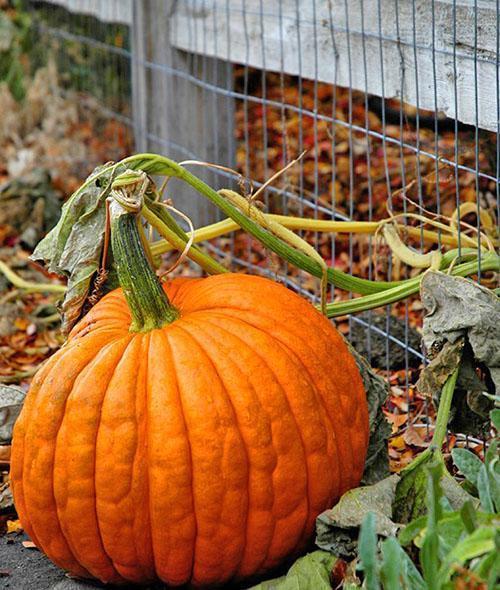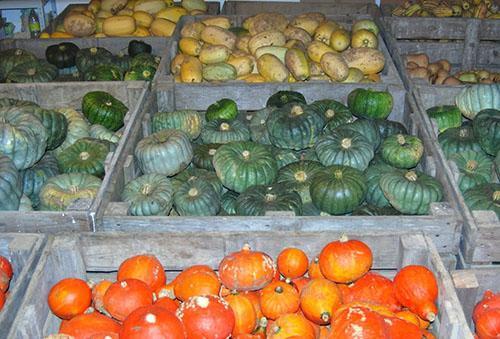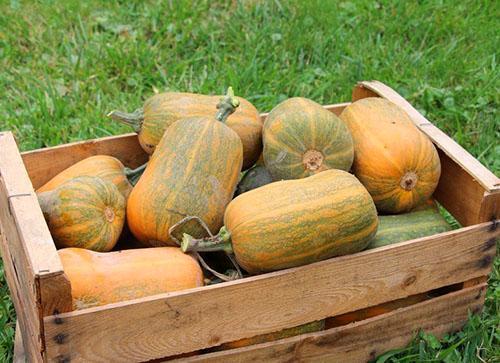Affordable ways to store your own hand-grown pumpkin
 The pumpkin, a regular in Russian garden beds, has many advantages. The vegetable is not capricious and easy to grow, even a beginner will master it, and the fruits collected in autumn are a component of a variety of dishes and a storehouse of useful substances for all family members.
The pumpkin, a regular in Russian garden beds, has many advantages. The vegetable is not capricious and easy to grow, even a beginner will master it, and the fruits collected in autumn are a component of a variety of dishes and a storehouse of useful substances for all family members.
The unique vitamin and mineral complex present in the pulp and seeds of pumpkin helps to recharge with energy in winter, lose extra pounds and support immunity. Pumpkin is considered an excellent product for baby and diet food. For lovers of delicious homemade food, pumpkin gives the opportunity to diversify the menu with aromatic cereals and stews, candied fruits and jam, juice and pastries.
However, anticipating acquaintance with gastronomic delights, rejoicing at the end of summer labors, the summer resident will have to solve an equally important task. Delicious and healthy pumpkin dishes will be only when the fruits are provided with proper storage conditions.
How to store pumpkin in winter? Under what conditions will ripe pumpkins not deteriorate, their pulp will remain as sweet, dense and juicy as in autumn?
How to collect and store pumpkin in winter?

The choice of summer residents today is offered up to hundreds of different varieties and hybrids, ripening at different times and bearing fruits of all shapes and colors. Therefore, the harvest time is stretched from mid-August to November.
The most difficult thing is for gardeners in the middle zone, the Urals, the North-West of the country and Siberia. Here summer residents are often forced to cut pumpkins from the whip, which require a long ripening.
But even in these conditions, knowing how to store pumpkin, you can save and use the grown with benefit. A sign that pumpkin ready to take a place in the storage and spend more than one month there, we can assume:
- the stalk hardened, turned into a cork;
- wilting of the whip on which the fruit grows, and the foliage around;
- strong bark of the fetus, not broken when exposed to a nail;
- the appearance in the color of pumpkins of flowers inherent in a ripe fruit.
 When harvesting, experienced gardeners try not to pluck or unscrew the fruits, but carefully cut them off, so that the pumpkin is stored in winter with a shank of at least 4–6 cm in length. harmful fungi and bacteria immediately settle, and the fruit begins to rot. A similar process takes place when fruits are stored:
When harvesting, experienced gardeners try not to pluck or unscrew the fruits, but carefully cut them off, so that the pumpkin is stored in winter with a shank of at least 4–6 cm in length. harmful fungi and bacteria immediately settle, and the fruit begins to rot. A similar process takes place when fruits are stored:
- damaged by rodents or garden tools;
- with cracks and bruises;
- foci of diseases on the bark.
The best time to harvest is dry, sunny days, when the fruits can be spread out in a ventilated, lighted place to dry. If the weather permits, in the cool autumn sun, the harvest is left for a week.
During this time, the bark hardens further, the pulp becomes sweeter, and even small scratches on the peel are slightly tightened. Such pumpkins are stored better in winter, and when they are cut, they delight with both taste and juiciness.
 The ideal place for storing pumpkins in winter is considered to be dry, ventilated basements... Here, at temperatures from 5 to 10 ° C, the fruits are immersed in a state close to hibernation. All processes in them are inhibited, only a very slow evaporation of moisture and the conversion of starch into sugar occurs.
The ideal place for storing pumpkins in winter is considered to be dry, ventilated basements... Here, at temperatures from 5 to 10 ° C, the fruits are immersed in a state close to hibernation. All processes in them are inhibited, only a very slow evaporation of moisture and the conversion of starch into sugar occurs.
- If the air in the place chosen for storing the pumpkin is humid and there is no ventilation, it is likely that over time, foci of mold and rot will appear on the surface of the pilaf, and soon the flesh will be damaged.
- Equally negative is the effect on the harvested pumpkins and freezing temperatures. The damaged bark softens and the pumpkin rots.
Asking the question of how to injure a pumpkin, the summer resident needs to prepare ventilated dry and clean shelves or pallets for fruits. Pumpkins, disassembled by variety and shelf life, are laid on them so that there was no contact with the floor or walls, on which condensation is possible.
During storage, fruit crowding should not be allowed. If necessary, they are shifted with wrapping paper or straw. It will be better if the stalks are on top.
 With simple but effective safety measures, as well as with regular inspection of the crop, pumpkin that has begun to rot will be quickly noticed and removed. The rest of the fruits will remain dry and healthy.
With simple but effective safety measures, as well as with regular inspection of the crop, pumpkin that has begun to rot will be quickly noticed and removed. The rest of the fruits will remain dry and healthy.
But not always, even if all storage conditions are met, pumpkins can please the gardener who grew them. The fact is that each variety has its own deadline when the pumpkin is stored without loss of quality. Early varieties, such as Gymnosperm Gourd or today's popular butternut fruits, are best eaten within 3-5 months of harvest. Otherwise, you can face a situation when seeds begin to germinate inside the fruit, and the pulp completely loses all its consumer qualities.
How to store a pumpkin in an apartment
 A basement or other suitable room suitable for storing crops always helps the summer resident well. But what if the gardener has only a city apartment at his disposal? In addition to the fact that the pumpkin harvest takes up a lot of space, you need to create comfortable conditions for vegetables. Is it possible to store a pumpkin in an apartment, and how to protect the fruit from drying out inevitably in the heat?
A basement or other suitable room suitable for storing crops always helps the summer resident well. But what if the gardener has only a city apartment at his disposal? In addition to the fact that the pumpkin harvest takes up a lot of space, you need to create comfortable conditions for vegetables. Is it possible to store a pumpkin in an apartment, and how to protect the fruit from drying out inevitably in the heat?
The rules for storing pumpkin both in the basement and in a heated room have a lot in common. Fruits thrive better in a dry, dark place where there is ventilation.
All this can be achieved by spreading the pumpkins in the pantry. The main thing is that there are no heating appliances nearby, the pumpkins are not exposed to negative temperatures, and, if possible, do not touch.
Even a glazed balcony or loggia can become a temporary shelter for vegetables collected from the beds. Here they are placed on shelves or in boxes, covered with a thick cloth to protect them from the sun and possible frost. When it gets cold, the fruits are transferred to the apartment and the pumpkins are stored until it gets warmer outside.
 If there is no suitable place for storing whole fruits, it remains to dry the pulp and pumpkin seeds, process the crop into homemade canned food, juice and puree. Are there other ways to store pumpkins in winter? And what to do if you can't eat the fruit grown on the site at one time?
If there is no suitable place for storing whole fruits, it remains to dry the pulp and pumpkin seeds, process the crop into homemade canned food, juice and puree. Are there other ways to store pumpkins in winter? And what to do if you can't eat the fruit grown on the site at one time?
How to store cut pumpkin?
 Large-fruited pumpkin varieties are stored longer than others, but having cut such a fruit, even a friendly family sometimes finds it difficult to eat it right away. Do not throw away most of the pumpkin if only a small slice is spent on mashed potatoes or juice for the child? The question of how to store a cut pumpkin is also of interest to those summer residents who, when revising the harvest, find slightly spoiled specimens.
Large-fruited pumpkin varieties are stored longer than others, but having cut such a fruit, even a friendly family sometimes finds it difficult to eat it right away. Do not throw away most of the pumpkin if only a small slice is spent on mashed potatoes or juice for the child? The question of how to store a cut pumpkin is also of interest to those summer residents who, when revising the harvest, find slightly spoiled specimens.
Since the pumpkin pulp contains a lot of sugars, a tasty food for bacteria, you won't be able to save a cut pumpkin for a long time. Well washed, seeded, and sliced pumpkin has a maximum shelf life of two weeks.Moreover, such a fruit should be tightly wrapped in cling film and stored in the refrigerator. At a temperature of 2–6 ° C, the development of pathogenic flora is inhibited, but does not stop, so it is better to eat the sweetest varieties as soon as possible.
Instead of a film, you can use foil, but since this material does not protect against dehydration, the slices of the cut pumpkin intended for storage are pretreated with refined vegetable oil.
Freezing pulp will extend the shelf life of the cut fruit. Moreover, this method is not at all laborious and simple.
Can pumpkin be frozen in the freezer?
 Quick freezing of vegetables has recently become one of the most popular ways to preserve the harvest. This is due to the fact that the fruits do not lose the lion's share of their beneficial properties, they retain the aroma and taste characteristic of the culture. This fully applies to the pumpkin intended for winter storage.
Quick freezing of vegetables has recently become one of the most popular ways to preserve the harvest. This is due to the fact that the fruits do not lose the lion's share of their beneficial properties, they retain the aroma and taste characteristic of the culture. This fully applies to the pumpkin intended for winter storage.
If juicy melon cannot be frozen without loss of consistency, the dense pumpkin pulp easily tolerates sub-zero temperatures. But it is better not to send large pieces to the freezer entirely. It will take a long time to defrost them, which will inevitably lead to a deterioration in the quality of the product.
It is much easier and more convenient to freeze the pumpkin sent to the freezer in the form of small cubes. This method saves storage space, but in winter it seriously reduces the time for preparing your favorite pumpkin dishes, because the cubes are completely ready to be sent to a pan or saucepan.
To prevent the vegetable from losing its consistency when defrosting, after removing the pulp from the freezer, it is important to transfer it to the vegetable compartment. Here, at temperatures close to zero, the pumpkin will defrost, but will not lose moisture.
There is another way you can freeze pumpkin in the freezer. In this case, not cubes are sent to the chamber, but mashed potatoes made from baked pulp. Before the pumpkin goes into the refrigerator, it is washed, cut into large pieces and the seeds are removed along with the loose fibrous core.
 Pieces of pumpkin, pulp down, are laid out on baking trays, which are placed in the oven for 30-40 minutes, during which the pulp will soften.
Pieces of pumpkin, pulp down, are laid out on baking trays, which are placed in the oven for 30-40 minutes, during which the pulp will soften.
 The peel is carefully removed from the cooled pumpkin, and the resulting pulp is chopped in a meat grinder or blender until a smooth, homogeneous mass.
The peel is carefully removed from the cooled pumpkin, and the resulting pulp is chopped in a meat grinder or blender until a smooth, homogeneous mass.
 Pumpkin puree, which retains all the properties and taste of a vegetable, is packaged in tightly closing small bags that can hold a portion per use of the product, or in ice molds.
Pumpkin puree, which retains all the properties and taste of a vegetable, is packaged in tightly closing small bags that can hold a portion per use of the product, or in ice molds.
In the freezer, frozen pumpkin can be stored for up to one year. It is only important to remember that repeated freezing of vegetable pulp is unacceptable.
They use the same tasty and healthy product for making soups, baby food, caviar, jam, baked goods and desserts.